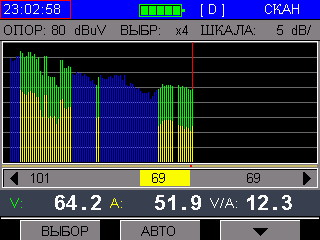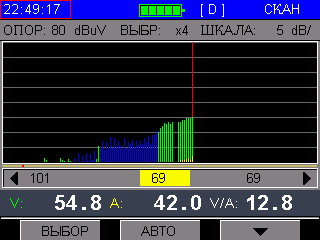Cable TV networks for the smallest. Part 2: Composition and waveform

The signal transmitted over the cable television network is a broadband, frequency-divided spectrum. Signal parameters, including frequencies and channel numbers in Russia, are regulated by GOST 7845-92 and GOST R 52023-2003, but the operator is free to choose the content of each channel at his discretion.
Content of a series of articles
- Part 1: The overall architecture of the CATV network
- Part 2: Composition and waveform
- Part 3: Analog Signal Component
- Part 4: The digital component of the signal
- Part 5: Coaxial distribution network
- Part 6: RF Amplifiers
- Part 7: Optical Receivers
- Part 8: Optical Trunk Network
- Part 9: Head Station
- Part 10: Troubleshooting on a CATV network
Let me remind you that I am not writing a textbook, but an educational program for expanding horizons and entering the world of cable TV. Therefore, I try to write in simple language, leaving keywords for those interested and not delving into the description of technologies that have been perfectly described hundreds of times without me.
What we measure
For information about the signal in a coaxial cable, our technical staff uses mainly the device Deviser DS2400T.
')

In essence, this is a television receiver, but instead of image and sound, we see quantitative and qualitative characteristics of both the entire spectrum and individual channels. The illustrations below are screenshots from this device.
Such a Deviser even has a bit of redundant functionality, but there are devices more abruptly: with a screen showing the TV image directly, receiving an optical signal and, what the Deviser lacks, receiving a DVB-S satellite signal (but this is a completely different story).
Signal spectrum
Quickly assess the state of the signal "by eye" allows the display mode

In this mode, the device scans channels in accordance with the specified frequency plan. For convenience, the frequencies that are not used in our network are removed from the full spectrum; therefore, the resulting image is a paling of channels.

Digital channels are marked in blue, analogue in yellow. The green part of the analog channel is the difference between the audio and video components of the signal (GOST should be from 10 to 20 dB).
The difference in the levels of different channels is clearly noticeable: a separate non-uniformity depends on the transponder settings at the head station, and the general difference between the upper and lower frequencies has a certain meaning, which I will discuss below.
In this mode, strong deviations from the norm will be clearly visible, and if there are serious problems in the network, this will be immediately apparent. For example, in the above image, two digital channels are missing in the high-frequency zone: they are present only in the form of short strips, barely reaching the level of 10dBmV (the reference level of 80dBmV is indicated at the top - this is the upper limit of the graph) yourself as an antenna or contributed by active equipment. These two channels - test and were turned off at the time of this writing.
The perplexity can cause uneven arrangement of digital and analog channels. This is of course not correct and was due to the evolutionary development of the network: additional channels were simply added to the frequency plan in the free part of the spectrum. When creating a frequency plan from scratch, it would be correct to place the entire analog in the lower part of the spectrum. In addition, station equipment for signal generation for European countries has restrictions on the use of frequencies for broadcasting a digital signal and, although in our country there are no such restrictions, using such equipment it is necessary to place digital channels in the spectrum against logic.
Waveform
As is known from fundamental physics, the higher the frequency of the wave, the stronger its attenuation as it propagates. When transmitting such a broadband signal, as the attenuation in the CATV network in the distribution network can reach tens of decibels per arm, and in the lower part of the spectrum it will be several times less. Therefore, having sent a steady signal to the riser from the basement, on the 25th floor we will see something like the following:

The level of the upper frequencies is noticeably less than the lower ones. In a real situation, a TV, if it is not understood, may consider weaker channels simply as noise and filter them. And if an amplifier is installed in the apartment, then when you try to configure it to receive high-quality channels from the top of the range, an over-power will occur at the bottom. Standards regulate the difference of no more than 15 dBµV for the entire range.
To avoid this, when you tune the active equipment, a higher level is initially laid down in the high frequency zone. This is called “straight slope,” or simply “slope.” And what is shown in the image is “reverse tilting,” and such a picture is already an accident. Or, at a minimum, an indication that the cable to the measuring point is a disaster.
There is also a reverse situation, when low frequencies are practically absent, and the upper ones barely make their way above the noise level:

It also tells us about the damage to the cable, namely its central core: the higher the frequency, the closer to the edge of the waveguide it spreads (skin effect in the coaxial cable). Therefore, we see only those channels that extend to the upper frequencies, but, as a rule, the TV will not be able to receive them with such a level.
Source: https://habr.com/ru/post/449902/
All Articles